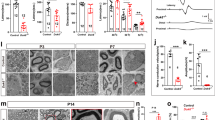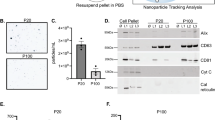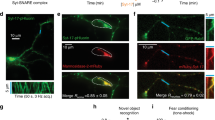Abstract
Binding of target-derived neurotrophins to Trk receptors at nerve terminals is required to stimulate neuronal survival, differentiation, innervation and synaptic plasticity. The distance between the soma and nerve terminal is great, making efficient anterograde Trk transport critical for Trk synaptic translocation and signaling. The mechanism responsible for this trafficking remains poorly understood. Here we show that the sorting receptor sortilin interacts with TrkA, TrkB and TrkC and enables their anterograde axonal transport, thereby enhancing neurotrophin signaling. Cultured DRG neurons lacking sortilin showed blunted MAP kinase signaling and reduced neurite outgrowth upon stimulation with NGF. Moreover, deficiency for sortilin markedly aggravated TrkA, TrkB and TrkC phenotypes present in p75NTR knockouts, and resulted in increased embryonic lethality and sympathetic neuropathy in mice heterozygous for TrkA. Our findings demonstrate a role for sortilin as an anterograde trafficking receptor for Trk and a positive modulator of neurotrophin-induced neuronal survival.
This is a preview of subscription content, access via your institution
Access options
Subscribe to this journal
Receive 12 print issues and online access
$209.00 per year
only $17.42 per issue
Buy this article
- Purchase on Springer Link
- Instant access to full article PDF
Prices may be subject to local taxes which are calculated during checkout







Similar content being viewed by others
Change history
14 January 2011
In the version of this article initially published, the right-hand panel of Figure 2f was inadvertently replaced by Figure 7b. The error has been corrected in the HTML and PDF versions of the article.
References
Chao, M.V. Neurotrophins and their receptors: a convergence point for many signalling pathways. Nat. Rev. Neurosci. 4, 299–309 (2003).
Hirokawa, N., Noda, Y., Tanaka, Y. & Niwa, S. Kinesin superfamily motor proteins and intracellular transport. Nat. Rev. Mol. Cell Biol. 10, 682–696 (2009).
Hirokawa, N. & Takemura, R. Molecular motors and mechanisms of directional transport in neurons. Nat. Rev. Neurosci. 6, 201–214 (2005).
Arimura, N. et al. Anterograde transport of TrkB in axons is mediated by direct interaction with Slp1 and Rab27. Dev. Cell 16, 675–686 (2009).
Willnow, T.E., Petersen, C.M. & Nykjaer, A. VPS10P-domain receptors—regulators of neuronal viability and function. Nat. Rev. Neurosci. 9, 899–909 (2008).
Nielsen, M.S. et al. The sortilin cytoplasmic tail conveys Golgi-endosome transport and binds the VHS domain of the GGA2 sorting protein. EMBO J. 20, 2180–2190 (2001).
Petersen, C.M. et al. Molecular identification of a novel candidate sorting receptor purified from human brain by receptor-associated protein affinity chromatography. J. Biol. Chem. 272, 3599–3605 (1997).
Sarret, P. et al. Distribution of NTS3 receptor/sortilin mRNA and protein in the rat central nervous system. J. Comp. Neurol. 461, 483–505 (2003).
Chen, Z.Y. et al. Sortilin controls intracellular sorting of brain-derived neurotrophic factor to the regulated secretory pathway. J. Neurosci. 25, 6156–6166 (2005).
Quistgaard, E.M. et al. Ligands bind to Sortilin in the tunnel of a ten-bladed beta-propeller domain. Nat. Struct. Mol. Biol. 16, 96–98 (2009).
Munck Petersen, C. et al. Propeptide cleavage conditions sortilin/neurotensin receptor-3 for ligand binding. EMBO J. 18, 595–604 (1999).
Nykjaer, A. et al. Sortilin is essential for proNGF-induced neuronal cell death. Nature 427, 843–848 (2004).
Teng, H.K. et al. ProBDNF induces neuronal apoptosis via activation of a receptor complex of p75NTR and sortilin. J. Neurosci. 25, 5455–5463 (2005).
Martin-Zanca, D., Oskam, R., Mitra, G., Copeland, T. & Barbacid, M. Molecular and biochemical characterization of the human trk proto-oncogene. Mol. Cell. Biol. 9, 24–33 (1989).
Runeberg-Roos, P. & Saarma, M. Neurotrophic factor receptor RET: structure, cell biology, and inherited diseases. Ann. Med. 39, 572–580 (2007).
Gomes, R.A., Hampton, C., El-Sabeawy, F., Sabo, S.L. & McAllister, A.K. The dynamic distribution of TrkB receptors before, during, and after synapse formation between cortical neurons. J. Neurosci. 26, 11487–11500 (2006).
Reichardt, L.F. Neurotrophin-regulated signalling pathways. Phil. Trans. R. Soc. Lond. B 361, 1545–1564 (2006).
Russell, F.D., Koishi, K., Jiang, Y. & McLennan, I.S. Anterograde axonal transport of glial cell line-derived neurotrophic factor and its receptors in rat hypoglossal nerve. Neuroscience 97, 575–580 (2000).
Thang, S.H., Kobayashi, M. & Matsuoka, I. Regulation of glial cell line-derived neurotrophic factor responsiveness in developing rat sympathetic neurons by retinoic acid and bone morphogenetic protein-2. J. Neurosci. 20, 2917–2925 (2000).
Lee, K.F. et al. Targeted mutation of the gene encoding the low affinity NGF receptor p75 leads to deficits in the peripheral sensory nervous system. Cell 69, 737–749 (1992).
Ernfors, P., Lee, K.F., Kucera, J. & Jaenisch, R. Lack of neurotrophin-3 leads to deficiencies in the peripheral nervous system and loss of limb proprioceptive afferents. Cell 77, 503–512 (1994).
Klein, R. et al. Targeted disruption of the trkB neurotrophin receptor gene results in nervous system lesions and neonatal death. Cell 75, 113–122 (1993).
Minichiello, L. et al. Differential effects of combined trk receptor mutations on dorsal root ganglion and inner ear sensory neurons. Development 121, 4067–4075 (1995).
Bergmann, I. et al. Analysis of cutaneous sensory neurons in transgenic mice lacking the low affinity neurotrophin receptor p75. Eur. J. Neurosci. 9, 18–28 (1997).
Arnett, M.G., Ryals, J.M. & Wright, D.E. Pro-NGF, sortilin, and p75NTR: potential mediators of injury-induced apoptosis in the mouse dorsal root ganglion. Brain Res. 1183, 32–42 (2007).
Klein, R. et al. Disruption of the neurotrophin-3 receptor gene trkC eliminates la muscle afferents and results in abnormal movements. Nature 368, 249–251 (1994).
Fariñas, I., Jones, K.R., Backus, C., Wang, X.Y. & Reichardt, L.F. Severe sensory and sympathetic deficits in mice lacking neurotrophin-3. Nature 369, 658–661 (1994).
Carroll, P., Lewin, G.R., Koltzenburg, M., Toyka, K.V. & Thoenen, H. A role for BDNF in mechanosensation. Nat. Neurosci. 1, 42–46 (1998).
Perez-Pinera, P. et al. Characterization of sensory deficits in TrkB knockout mice. Neurosci. Lett. 433, 43–47 (2008).
Chuang, H.H. et al. Bradykinin and nerve growth factor release the capsaicin receptor from PtdIns(4,5)P2-mediated inhibition. Nature 411, 957–962 (2001).
Silos-Santiago, I. et al. Non-TrkA-expressing small DRG neurons are lost in TrkA deficient mice. J. Neurosci. 15, 5929–5942 (1995).
Coderre, T.J., Grimes, R.W. & Melzack, R. Deafferentation and chronic pain in animals: an evaluation of evidence suggesting autotomy is related to pain. Pain 26, 61–84 (1986).
Smeyne, R.J. et al. Severe sensory and sympathetic neuropathies in mice carrying a disrupted Trk/NGF receptor gene. Nature 368, 246–249 (1994).
Jansen, P. et al. Roles for the pro-neurotrophin receptor sortilin in neuronal development, aging and brain injury. Nat. Neurosci. 10, 1449–1457 (2007).
Mu, X., Silos-Santiago, I., Carroll, S.L. & Snider, W.D. Neurotrophin receptor genes are expressed in distinct patterns in developing dorsal root ganglia. J. Neurosci. 13, 4029–4041 (1993).
Hermans-Borgmeyer, I., Hermey, G., Nykjaer, A. & Schaller, C. Expression of the 100-kDa neurotensin receptor sortilin during mouse embryonal development. Brain Res. Mol. Brain Res. 65, 216–219 (1999).
Horton, A.C. & Ehlers, M.D. Neuronal polarity and trafficking. Neuron 40, 277–295 (2003).
Merianda, T.T. et al. A functional equivalent of endoplasmic reticulum and Golgi in axons for secretion of locally synthesized proteins. Mol. Cell. Neurosci. 40, 128–142 (2009).
Kamal, A., Almenar-Queralt, A., LeBlanc, J.F., Roberts, E.A. & Goldstein, L.S. Kinesin-mediated axonal transport of a membrane compartment containing beta-secretase and presenilin-1 requires APP. Nature 414, 643–648 (2001).
Kjolby, M. et al. Sort1, encoded by the cardiovascular risk locus 1p13.3, is a regulator of hepatic lipoprotein export. Cell Metab. 12, 213–223 (2010).
Jenkins, P.M., Zhang, L., Thomas, G. & Martens, J.R. PACS-1 mediates phosphorylation-dependent ciliary trafficking of the cyclic-nucleotide-gated channel in olfactory sensory neurons. J. Neurosci. 29, 10541–10551 (2009).
Ascaño, M., Richmond, A., Borden, P. & Kuruvilla, R. Axonal targeting of Trk receptors via transcytosis regulates sensitivity to neurotrophin responses. J. Neurosci. 29, 11674–11685 (2009).
Wallrabe, H., Elangovan, M., Burchard, A., Periasamy, A. & Barroso, M. Confocal FRET microscopy to measure clustering of ligand-receptor complexes in endocytic membranes. Biophys. J. 85, 559–571 (2003).
Blackstone, C.D. et al. Biochemical characterization and localization of a non-N-methyl-D-aspartate glutamate receptor in rat brain. J. Neurochem. 58, 1118–1126 (1992).
Huber, L.J. & Chao, M.V. Mesenchymal and neuronal cell expression of the p75 neurotrophin receptor gene occur by different mechanisms. Dev. Biol. 167, 227–238 (1995).
Chen, C.L. et al. Runx1 determines nociceptive sensory neuron phenotype and is required for thermal and neuropathic pain. Neuron 49, 365–377 (2006).
Holmes, F.E. et al. Targeted disruption of the galanin gene reduces the number of sensory neurons and their regenerative capacity. Proc. Natl. Acad. Sci. USA 97, 11563–11568 (2000).
Zwick, M. et al. Glial cell line-derived neurotrophic factor is a survival factor for isolectin B4-positive, but not vanilloid receptor 1-positive, neurons in the mouse. J. Neurosci. 22, 4057–4065 (2002).
Wetzel, C. et al. A stomatin-domain protein essential for touch sensation in the mouse. Nature 445, 206–209 (2007).
Sokoloff, A.J., Li, H. & Burkholder, T.J. Limited expression of slow tonic myosin heavy chain in human cranial muscles. Muscle Nerve 36, 183–189 (2007).
Acknowledgements
We thank L. Reichardt (University of California, San Francisco) for the TrkA antibody. The ImageJ KymoToolBox plug-in was kindly provided by F. Cordelières (Université Paris-Sud Orsay), and the NeuriteTracer plug-in by M. Pool (Rue University). This work was supported by the Lundbeck Foundation, The Danish Medical Research Council, Elvira and Rasmus Rissforts Foundation, MEMORIES (European Union, Framework Programme 6), US National Institutes of Health (NS21072, AG025970 and HD23315), the Deutsche Forschungsgemeinschaft, Danish Council for Strategic Research, and Center for Stochastic Geometry and Advanced Bioimaging (Villum Foundation).
Author information
Authors and Affiliations
Contributions
C.B.V., P.J., A.W.F., S.G., S.S., M.R., M.K. and B.E. conducted the experiments. J.R.N., L.T., G.R.L., T.E.W. and M.V.C. provided reagents and scientific input. C.B.V. and A.N. designed the experiments and evaluated the data, and C.B.V. and A.N. wrote the manuscript.
Corresponding authors
Ethics declarations
Competing interests
The authors declare no competing financial interests.
Supplementary information
Supplementary Text and Figures
Supplementary Figures 1–7 (PDF 443 kb)
Supplementary Video 1
Live cell imaging of a WT DRG neuron transfected with EGFP-TrkA (AVI 807 kb)
Supplementary Video 2
Live cell imaging of a Sort1−/− DRG neuron transfected with EGFP-TrkA (AVI 1617 kb)
Supplementary Video 3
Characteristic waddling gate in sortilin and p75NTR double knockout mouse (AVI 458 kb)
Rights and permissions
About this article
Cite this article
Vaegter, C., Jansen, P., Fjorback, A. et al. Sortilin associates with Trk receptors to enhance anterograde transport and neurotrophin signaling. Nat Neurosci 14, 54–61 (2011). https://doi.org/10.1038/nn.2689
Received:
Accepted:
Published:
Issue Date:
DOI: https://doi.org/10.1038/nn.2689
This article is cited by
-
The Possible Role of Brain-derived Neurotrophic Factor in Epilepsy
Neurochemical Research (2024)
-
Candidate Key Proteins in Tinnitus: A Bioinformatic Study of Synaptic Transmission in Spiral Ganglion Neurons
Cellular and Molecular Neurobiology (2023)
-
Finding memo: versatile interactions of the VPS10p-Domain receptors in Alzheimer’s disease
Molecular Neurodegeneration (2022)
-
The emerging role of furin in neurodegenerative and neuropsychiatric diseases
Translational Neurodegeneration (2022)
-
Sortilin deletion in the prefrontal cortex and hippocampus ameliorates depressive-like behaviors in mice via regulating ASM/ceramide signaling
Acta Pharmacologica Sinica (2022)



